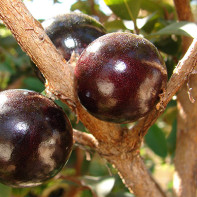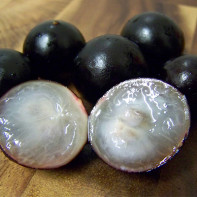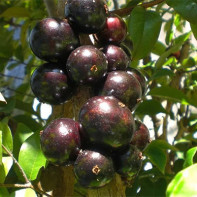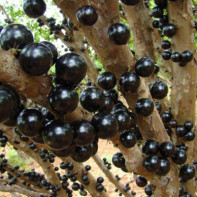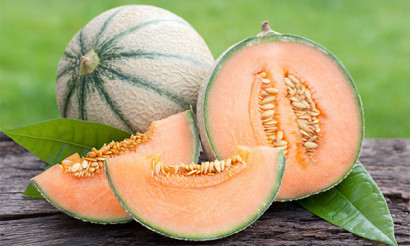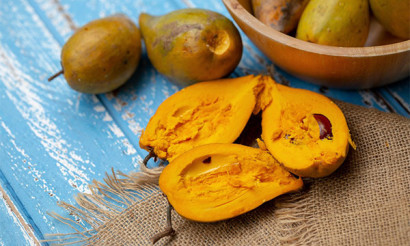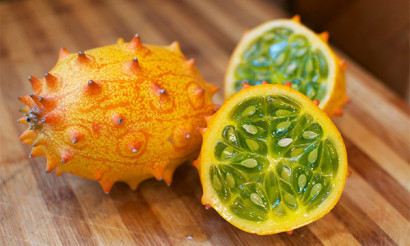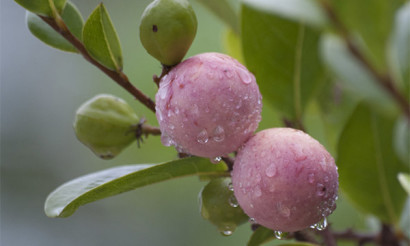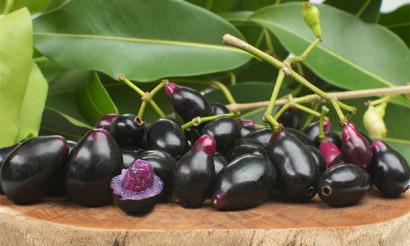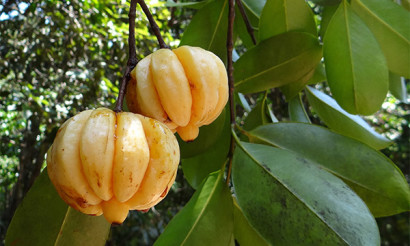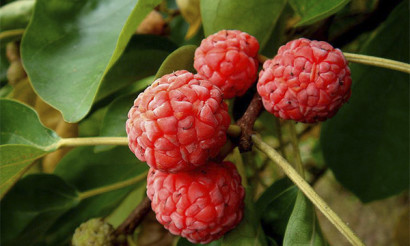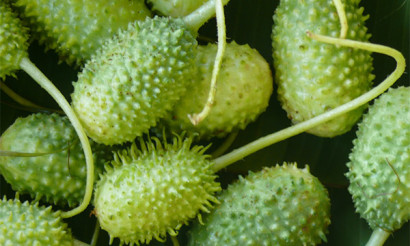Jaboticaba: what kind of fruit is it and how is it healthy
- What is this fruit
- What does it look like
- Where grows
- What is the use of jaboticaba
- Which may be harmful
- How to eat jabotababa
- What can be cooked from jaboticaba
- Brazilian Vitamin Salad
- Tropical smoothie
- Jabotababa Wine
- Application in traditional medicine
- How to grow
- Jaboticaba in the open ground
- Indoor cultivation
- Interesting Facts
The plant world is sometimes striking in its diversity and originality. What wonderful trees, bushes and flowers do not exist on earth! You never cease to be amazed at the fantasies of Mother Nature. Take, for example, a tree with the exotic name of Jaboticaba. Many of us have never heard of him. However, at home in South America, this tree is very popular.
What is this fruit
Jaboticaba, or as it is also called - jabotababo, belongs to the Mirtov family. This is a fruit crop, which in its appearance and taste is somewhat reminiscent of grapes. However, jabotababa berries are distinguished by a more delicate, slightly bitter notes due to the large amount of tannin contained in them. Of particular note is the amazing arrangement of these same berries on a tree.
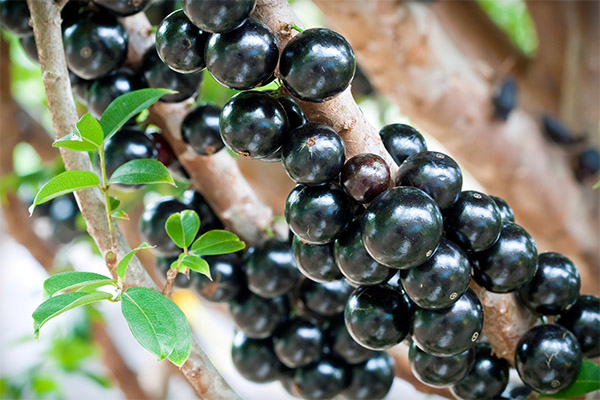
What does it look like
Jabotababa fruits grow directly on the surface of the trunk and thick branches. Because of this, it seems that the tree is strewn with large purple balls. Jaboticaba is incredibly beautiful during the flowering period when large white flowers with long tufts of stamens cover the entire surface. The tree becomes like an alien creature that came to us from distant galaxies.
The trunk of the jabotababa has a characteristic pinkish tint with gray spots. The crown, although sprawling, but small, is covered with oval leaves of delicate pink color. Over time, they acquire a more traditional green color.
Where grows
This amazing tree grows mainly in tropical regions such as Brazil, Bolivia, Paraguay, Argentina, the Philippines, Cuba and the Caribbean. However, thanks to the unpretentiousness, they began to grow jabotikabu in many other countries of the world. The tree adapts well to various conditions, grows well in alkaline earth.
With proper watering, Brazilian grapes will provide their owner with a rich harvest several times a year. Yes, another amazing quality of this plant is its rich fertility. New jabotababa berries usually ripen in just 3-4 weeks.
What is the use of jaboticaba
Brazilian grapes are extremely beneficial to the body. It contains a huge amount of various vitamins, minerals and amino acids. Jaboticaba fruits have long been used in the treatment of sore throat, asthma, dysentery and diarrhea. It is a great source of antioxidants. Recently, scientists have been actively studying jabotikaba as a means of combating cancer. However, despite the number of useful properties of this plant, it is worth being careful when eating it.
Which may be harmful
First of all, it is necessary to note a possible allergic reaction to the berries of Brazilian grapes, which, as a rule, is accompanied by headaches, characteristic rashes on the body and muscle cramps. The peel of jabotababa fruits also contains a large amount of toxins. Therefore, their excessive use is more likely to bring the body more harm than good.
In addition, Brazilian grapes can adversely affect kidney and liver function. It is strictly contraindicated in pregnant and lactating women, as well as people with diabetes, epilepsy and thrombophlebitis.
How to eat jabotababa
If you still decide to try this exotic fruit, it is worth remembering that they eat it, mostly fresh. To do this, gently bite the shell and squeeze the pulp into the mouth.
The skin of the jabotikaba has a bitter taste, so it is rarely eaten and thrown away with the bone. Brazilian grapes tend to deteriorate very quickly.
It is impossible to store it in the refrigerator for more than three to four days, it begins to wander. However, fermented berries can make excellent wine.
What can be cooked from jaboticaba
In general, jaboticaba is very popular in cooking, there are many different recipes using this exotic fruit. Berries are used to make jellies, sauces, preserves and marmalades, as well as delicious liquors and soft drinks. Here are some useful and at the same time delicious recipes for jabotababa dishes.
Brazilian Vitamin Salad
Chop green onions and dill into a glass bowl. Add to the greens 2 mashed cloves of garlic, a glass of jabotababa, salt and pepper to taste. All this pour 2 teaspoons of vinegar and 1 tablespoon of water. Close the container and refrigerate for a day. Then sprinkle pickled jabotababa with finely chopped green onions. Prepare the dressing separately. To do this, mix 1 tablespoon of vinegar and water with 5 tablespoons of vegetable oil. Pour the dressing with the resulting dressing and mix it thoroughly.
Tropical smoothie
Peel a ripe banana. Remove core from apple. Peel the jabotikabu skin. Place all fruits in a blender and pour 100 ml of milk. Then beat until foam appears. If desired, you can add a pinch of vanillin or cinnamon.
Jabotababa Wine
Gently squeeze the juice out of 5 kg of jabotababa while removing the skin and bones. Then mix in a separate container with 75 g of cinnamon and 100 g of clove, respectively. To seasonings add 1 teaspoon of pepper, a little chopped ginger and 1 tablespoon of nutmeg. If desired, you can add 15 g of wormwood. Place the mixture of spices in a small bag and put on the bottom of the glass bottle. On top of the bag pour freshly squeezed juice jabotikaba. The liquid should be infused for at least 7 weeks in a dark, cool place. Once the precipitate has completely separated, pass the wine through cheesecloth and bottle.
Application in traditional medicine
Among other things, jabotababa is widely used in traditional medicine. From the skin of berries of Brazilian grapes make a useful decoction that helps in the fight against diarrhea and asthma.

Broth recipe
To prepare this broth, first of all, you will need a dried in the shade peel of a jabotababa. To do this, carefully cut the surface of the berry and squeeze the flesh with the bone. The resulting skins (approximately 2 tablespoons) leave to dry in a dark, dry place until they reach the desired condition. Then pour them with two glasses of boiled water and let it brew for several hours. After all this, strain the resulting broth through a sieve or cheesecloth. Discard the peel, and dilute the tincture with water to the original volume. It is recommended to use a decoction of zhabotikaba regularly and several times a day, then the result will be especially successful.
Also, tincture can be made on the basis of alcohol. The drink will turn out to be strong and aromatic, in quality not inferior to store alcohol in anything and, among other things, also very useful. Freshly squeezed juice can be made from the berries of Brazilian grapes, which will be very useful in treating diarrhea and abdominal pain. Jabotababa skins are an excellent food coloring.
How to grow
As mentioned above, jabotikabu is grown mainly in tropical regions, with a warm temperate climate. This fruit crop does not tolerate even short-term small frosts. But thanks to its decorativeness, more and more often small trees of Brazilian grapes appear indoors.
Jaboticaba in the open ground
Jaboticaba is growing slowly, but the result is worth it. Rich abundant harvests of this exotic tree will surely please their owners. When planting Brazilian grapes, it should be borne in mind that this crop feels great in light, well-drained soil, does not tolerate salinization, and does not tolerate drought, so regular and plentiful watering is necessary. Outdoors, it is best to plant jabotababa in the shade, like any other tropical culture.
It is also necessary to feed the tree with complex mineral fertilizers. They are brought in, as a rule, in the spring-summer season, and gradually stop by autumn. Jabotababa is not particularly pruned. You can remove heavy and dry branches in the upper part of the crown and thin out thickened places. In practice, it was noticed that trees with a slightly loose crown give a particularly rich harvest. Pruning should be done before the start of shoot growth.
Indoor cultivation
For growing jabotababa indoors, seeds or seedlings are used. The first crop of seeds will be only 10-14 years after planting, so lovers of exotic prefer grafted hybrid seedlings more. They bloom for the fourth year, decorate the interior and fill the air with a pleasant myrtle aroma. The soil mixture for decorative zhabotikaba is prepared on the basis of peat, sand, humus and leafy soil. Initially, the seedling is lowered for several hours into the root solution. Then, if necessary, pruning the roots. After all this, the seedling is immersed in a prepared container with the soil mixture, covered with a slide and watered abundantly with water.
Jaboticaba is very picky in care. It is necessary to monitor the dryness of the earth, to prevent overdrying of the soil. The plant is watered with warm, settled water, but at the same time avoiding stagnation in the pan. Decorative jabotikaba is fed with complex mineral fertilizers. Top dressing is applied once a month based on the age of the plant. In winter, they give the culture a rest and do not produce nutrition with minerals.
With a large growth of the root system, a transplant is performed. Jaboticab root pruning is absolutely painless. Like its free relatives, home-made Brazilian grapes produce a plentiful crop with a loose crown.
They also monitor the possible occurrence of pests - aphids and spider mites. If these creatures have just settled on jabotikaba, they can be easily removed with a warm shower. The soil is tightly covered with cling film. If in time you do not notice the spread of parasites, and the damage done to the plant has become quite large, then biological preparations should be used. Such drugs include Itoverm, Spark-bio, Lepidocide, etc. These drugs do not cause any harm to humans. They should be prepared strictly according to the instructions attached to the packaging. Here, perhaps, are all the tricky secrets of growing this outlandish tree - jabotikaba.
Interesting Facts

- This name comes from the ancient Indian people of the Tupinamba tribe. Translated, it means "tortoise place." The reason for this was the observation of the Indians over turtles, who were very fond of enjoying the fruits of Brazilian grapes. The convenient arrangement of berries on the trunk and branches of the tree only once again contributed to this.
- Jaboticaba owes its most characteristic feature to a long evolutionary process. The phenomenon when the fruits grow on the trunk and branches of a tree is called caulifloria in botany. Jaboticaba thus adapted to the environment.It was easier for insects to pollinate flowers on the trunk, and for birds and animals it was easier to spread seeds.
- In Brazil, in general, this fruit crop is very famous. Poems and songs are composed in honor of her. So, for example, in one folklore composition, the taste of jabotikaba is compared with the kiss of a woman, and the smooth skin of berries is compared with the tender face of the girlfriend.
- It is also interesting that in Brazil there is a whole city named after this fruit culture - Jabotikable. And all because thousands of such trees grow in it, literally in all yards and gardens. During the flowering period, the city resembles a picture from some science fiction film, it is an incredibly beautiful and bewitching sight. And when it comes time to harvest, then the fun begins! Locals charge a million guests a fee just to check in to Jabotikable. But then visitors can collect as many berries of Brazilian grapes as their heart desires. Takeaway fruits, of course, are also sold, with huge quantities. Jams and various desserts from jabotababa are very popular in the world, so they are bought in buckets.
«Important: all information on the site is provided exclusively in fact-finding purposes. Before applying any recommendations, consult with a profile specialist. Neither the editors nor the authors are liable for any possible harm caused materials. "

